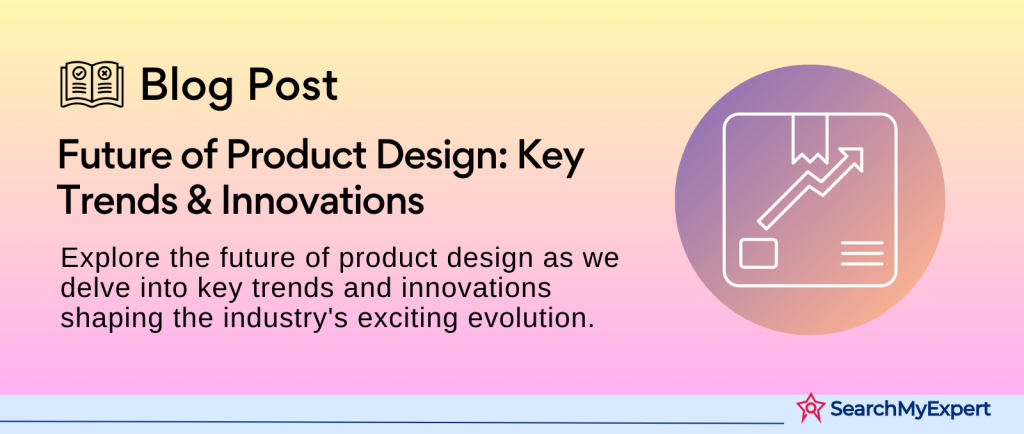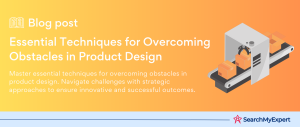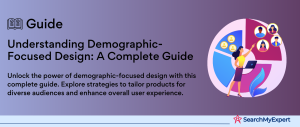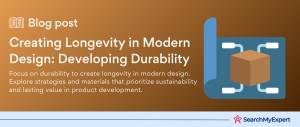The Evolution of Product Design Trends in Today’s Market
Product design trends are much more than fleeting fashions in the realm of product development and marketing. They represent a powerful undercurrent that shapes consumer behavior, influences purchasing decisions, and often dictates the success or failure of products in the market.
In this ever-evolving landscape, staying abreast of current design trends is not just about keeping up with aesthetic preferences. It’s about understanding the pulse of the market, anticipating consumer needs, and integrating innovation with functionality. The dynamic nature of these trends reflects a constantly changing consumer base, one that is increasingly informed, connected, and demanding.
Why Do Product Design Trends Matter?
- Consumer Engagement:
Trends in product design play a pivotal role in attracting and retaining consumer attention. They can make a product stand out in a crowded marketplace and create an emotional connection with potential buyers. - Brand Identity:
Effective incorporation of design trends can reinforce a brand’s identity and values. It’s a way for brands to communicate their understanding of current consumer needs and future aspirations. - Innovation and Relevance:
Staying relevant in a rapidly changing market means adapting and innovating. Trends often signify the direction in which technology, materials, and consumer preferences are moving. - Competitive Edge: Leveraging design trends can give companies a competitive advantage, distinguishing their products from others and often setting a benchmark in the industry.
The Impact on Consumer Behavior
- Preference Formation:
Design trends heavily influence how consumers perceive products, often forming the basis of their preferences. - Purchasing Decisions: A product that aligns with current design trends is more likely to be perceived as modern, desirable, and worth the investment.
- Brand Loyalty: Companies that consistently align with relevant design trends can foster stronger brand loyalty, as consumers often associate these brands with staying current and innovative.
As we delve deeper into the significance of product design trends, it’s crucial to remember that at their core, these trends are a reflection of evolving consumer needs and societal shifts. They are a blend of art and science, creativity and data, aesthetics and functionality. Understanding this interplay is key to creating products that not only look great but also resonate with consumers and stand the test of time in a dynamic market.
Megatrends Influencing Product Design in Contemporary Industries
In the dynamic world of product design, certain megatrends have emerged as influential forces, molding the way products are conceptualized, developed, and marketed across various industries. These trends not only reflect shifts in consumer preferences and societal values but also underscore the importance of innovation in meeting the evolving demands of the market.
Sustainability: A Core Design Principle
- Eco-Friendly Materials: The growing concern for environmental sustainability has led to an increased use of recycled and biodegradable materials in product design.
- Energy Efficiency:
Products are increasingly designed to minimize energy consumption, appealing to eco-conscious consumers. - Sustainable Production Processes:
There is a significant shift towards more sustainable manufacturing practices, reducing waste and minimizing the carbon footprint.
Urbanization: Design for Compact Living
- Space-Saving Solutions: As urban spaces become more compact, product design focuses on multifunctionality and space efficiency.
- Smart Home Products:
The rise in urban living has spurred the development of smart home devices that enhance comfort and convenience in limited spaces. - Mobility and Portability:
Urban lifestyles demand products that are easy to transport and use in various settings, from public transport to small apartments.
Advancements in Technology: The Digital Revolution
- Connectivity and IoT:
The Internet of Things (IoT) is shaping product design, with a growing number of products offering connectivity and smart features. - AI and Automation: Artificial intelligence and automation are becoming integral in product design, enhancing user experience and functionality.
- Augmented Reality (AR) and Virtual Reality (VR):
These technologies are being used to create immersive experiences, influencing product design in entertainment, education, and beyond.
The Impact on Design Priorities
- User-Centric Approach:
These megatrends have reinforced the need for a user-centric approach in design, focusing on convenience, usability, and personalization. - Innovative Solutions: Designers are constantly pushed to innovate, finding ways to integrate these trends into products that are both functional and aesthetically pleasing.
- Long-Term Value:
Products are now designed with a longer life span in mind, emphasizing durability and adaptability to future trends.
These megatrends are not just shaping the current landscape of product design but are also paving the way for future innovations. They challenge designers to think beyond traditional boundaries, creating products that are not only desirable but also responsible and forward-thinking.
Emerging Design Principles in the Forefront of Trend Evolution
In the realm of product design, several emerging principles are playing a pivotal role in guiding current trends. These principles not only reflect changing market dynamics but also represent a deeper understanding of user needs and societal shifts. Below, we discuss these principles and provide real-world examples of their application.
User-Centricity: Designing with the User in Mind
- Empathy-Driven Design:
Products are designed by deeply understanding the user’s needs, pains, and desires, ensuring functionality and ease of use. - Customization:
There’s an increasing trend towards products that can be customized to fit individual user preferences, enhancing personalization. - Example: Smartphones with customizable interfaces and adaptive features that cater to different user needs, from accessibility options for those with disabilities to personalized app recommendations.
Inclusivity: Design for All
- Universal Design:
Products are being created with a broad range of users in mind, considering different abilities, ages, and backgrounds. - Cultural Sensitivity: Designers are incorporating elements that respect and celebrate cultural diversity.
- Example:
User interfaces in technology products that support multiple languages and adaptive features for users with various physical abilities, like voice-controlled smart home devices.
Data-Driven Design: Leveraging Insights for Better Products
- Consumer Insights: Utilizing data analytics to understand consumer behavior and preferences for informed design decisions.
- Predictive Modeling: Using data to predict trends and user needs, allowing for proactive design strategies.
- Example:
Wearable fitness trackers that have evolved based on user data to include features like stress tracking, sleep quality analysis, and personalized workout recommendations.
Aesthetic and Functional Harmony
- Minimalism:
A trend towards simple, clean designs that are aesthetically pleasing yet highly functional. - Material Innovation:
Using new materials to enhance both the look and functionality of products. - Example:
Modern furniture designs that embody minimalism with multifunctional features, using sustainable materials for added environmental value.
Emotional Connection: Creating Products That Resonate
- Storytelling:
Designing products that tell a story or convey a message, creating a deeper emotional connection with the user. - Sensory Experience: Products that appeal to the senses, such as tactile materials or visually stimulating elements.
- Example: A coffee maker designed not just for brewing coffee but as a centerpiece of the kitchen, with a sleek design and sensory appeal through sight, sound, and touch.
Spotlight on Prominent Product Design Trends
In the dynamic sphere of product design, several trends stand out for their impact and relevance. These trends are not only shaping the current market but also hinting at the future of product innovation. Let’s dive into a few of these significant trends, exploring their characteristics, applications, and potential benefits.
Voice-Activated Interfaces: Revolutionizing Interaction
Core Characteristics:
- Hands-Free Operation:
Allowing users to interact with devices using voice commands, enhancing accessibility and convenience. - Natural Language Processing (NLP):
Advanced algorithms that understand and interpret human speech with increasing accuracy.
Applications:
- Smart Home Devices:
Voice-activated assistants in devices like smart speakers, thermostats, and lighting systems. - Automotive Systems:
In-car voice command systems for navigation, music control, and more.
Benefits:
- Enhanced Accessibility:
Making technology more accessible to people with disabilities or mobility issues. - Convenience and Efficiency:
Streamlining tasks and improving user experience.
Biomimicry: Inspired by Nature
Core Characteristics:
- Nature-Inspired Solutions:
Designing products by emulating nature’s time-tested patterns and strategies. - Sustainable Innovation:
Often results in more sustainable and efficient design solutions.
Applications:
- Architectural Design:
Structures inspired by natural forms for better energy efficiency and aesthetic appeal. - Material Science:
Developing new materials based on natural properties, like self-healing surfaces.
Benefits:
- Environmental Sustainability: Reducing environmental impact through natural efficiency.
- Innovative Problem Solving: Offering novel solutions by looking at how nature tackles similar challenges.
Modularity: Flexibility and Customization
Core Characteristics:
- Interchangeable Parts:
Products designed with components that can be rearranged or replaced. - Adaptability:
Allowing users to modify products according to changing needs or preferences.
Applications:
- Modular Smartphones:
Phones with interchangeable parts like cameras, batteries, or screens. - Furniture Design: Modular furniture systems adaptable to different space requirements.
Benefits:
- Personalization:
Tailoring products to individual needs and preferences. - Longevity and Sustainability: Extending product life by replacing or upgrading specific components.
Augmented Reality (AR) Integration: Enhancing Realities
Core Characteristics:
- Interactive Experiences:
Overlaying digital information onto the physical world to enhance user experience. - Technology Integration:
Combining AR with existing products to add value and functionality.
Applications:
- Retail Experiences:
AR mirrors in stores or AR apps for trying products virtually. - Educational Tools:
AR applications for interactive learning and exploration.
Benefits:
- Engaging User Experience: Creating immersive and interactive experiences for users.
- Educational Value:
Enhancing learning and exploration through interactive visualizations.
Challenges and Opportunities in Embracing Product Design Trends
Navigating the Complexities of Evolving Trends
Keeping pace with the ever-evolving landscape of product design trends is fraught with challenges, yet it presents numerous opportunities for innovation and differentiation. Understanding these aspects is crucial for designers, manufacturers, and marketers alike.
Challenges in Adopting New Trends
- Rapid Pace of Change: The speed at which trends evolve can make it difficult for companies to stay current and relevant.
- Resource Allocation:
Investing in new trends requires financial and human resources, which can be challenging, especially for smaller businesses. - Balancing Innovation and Practicality: Incorporating trendy elements while maintaining product functionality and cost-effectiveness can be a tightrope walk.
- Cultural and Market Variances:
Trends that resonate in one region or demographic may not have the same appeal elsewhere.
Opportunities Through Trend Adoption
- Enhanced User Experience: Embracing new design trends often leads to improved usability and customer satisfaction.
- Brand Differentiation: Innovative design can set a brand apart in a crowded market, building a unique identity.
- Market Advantage: Companies that successfully leverage trends can gain a competitive edge, appealing to trend-savvy consumers.
- Driving Innovation:
Trends often push the boundaries of what’s possible, leading to breakthroughs in materials, technology, and design methods.
Real-World Implications
- Adaptive Strategies: Companies must develop flexible strategies to quickly adapt to new trends, balancing risk and innovation.
- Consumer Insight: Understanding the target audience is key to determining which trends to adopt and how to implement them effectively.
- Sustainability Focus: In the face of environmental concerns, trends that emphasize sustainability can offer significant long-term benefits.
Visioning the Future: Emerging Trajectories in Product Design
As we peer into the future of product design, it becomes evident that the field is on the cusp of a transformative era. Current trends and emerging technologies are not just influencing present-day designs; they are carving out new paths for innovation and growth. Let’s explore the potential directions and areas where designers can expect significant evolution.
Emerging Technologies Shaping Tomorrow’s Designs
- Artificial Intelligence (AI) and Machine Learning (ML): The integration of AI into product design will revolutionize customization, allowing for products that adapt to user behaviors and preferences in real time.
- Internet of Things (IoT) Expansion: The proliferation of IoT will lead to a surge in interconnected products, offering seamless user experiences and enhanced functionalities across various aspects of life.
- Augmented and Virtual Reality (AR/VR): These technologies will increasingly blur the lines between digital and physical worlds, offering immersive and interactive product experiences.
Growth Areas in Product Design
- Sustainability and Eco-Design:
The focus on environmental impact will intensify, leading to more eco-friendly materials, sustainable production processes, and designs that promote a circular economy. - Health and Wellness Oriented Design: With a growing emphasis on personal health and well-being, products that monitor, encourage, and contribute to a healthier lifestyle will see significant growth.
- Personalization and Customization: Tailoring products to individual needs and preferences will become a standard expectation, driven by advancements in technology and data analytics.
Innovative Frontiers for Designers
- Material Science Innovations:
The development of new, sustainable materials will open up new possibilities for designers in terms of functionality, aesthetics, and environmental impact. - Ethical and Inclusive Design: There will be a stronger push towards inclusive designs that cater to a diverse range of users, as well as ethical considerations in sourcing and manufacturing.
- Smart Homes and Cities:
The integration of smart technology in homes and urban spaces will create opportunities for innovative product designs that enhance living and working environments.
As we look forward, it’s clear that the future of product design is not just about aesthetics or functionality in isolation. It’s about a holistic approach that encompasses user experience, technological advancements, sustainability, and social responsibility. Designers who embrace these evolving dynamics will be at the forefront of shaping a future where design not only looks good but also does good.
Navigating the Future: Embracing the Evolving World of Product Design
As we conclude our exploration of the dynamic and ever-evolving landscape of product design trends, let’s reflect on the key takeaways and consider the implications for designers, businesses, and consumers alike.
Key Takeaways from Product Design Trends
- Megatrends Driving Change: Trends such as sustainability, urbanization, and technological advancements are shaping the future of product design, necessitating a responsive and innovative approach.
- Principles Guiding Design:
Emerging principles like user-centricity, inclusivity, and data-driven design are essential for creating products that resonate with modern consumers and stand out in the market. - Influential Design Trends:
Trends like voice-activated interfaces, biomimicry, and modularity are redefining user experience, offering new possibilities for interaction, functionality, and customization. - Challenges and Opportunities:
While keeping pace with trends presents challenges, it also offers opportunities for enhanced user experience, brand differentiation, and a competitive edge. - The Future of Product Design: The integration of advanced technologies, a focus on sustainable and ethical practices, and the rising importance of personalization and health-oriented products are indicative of the future direction of product design.
Embracing the Future of Design
- Stay Informed and Agile:
Designers and businesses need to stay informed about emerging trends and technologies, adapting their strategies and designs to stay relevant and competitive. - Innovation and Flexibility: Embracing innovation, being open to change, and adopting a flexible approach are key to navigating the shifting landscape of product design.
- Ethical and Sustainable Practices:
Incorporating sustainable and ethical practices into design processes is not just a trend but a necessity, reflecting a growing consumer demand for responsible products. - Focus on User Experience:
Ultimately, the success of a product lies in its ability to meet and exceed user expectations, making user-centric design an indispensable aspect of product development.
As we move forward, the field of product design promises to be an exciting space, brimming with opportunities for innovation, creativity, and impact. For designers, staying at the forefront of these changes and harnessing the power of emerging trends will be key to crafting products that are not only successful in the market but also meaningful in people’s lives.
Collaborate for success with leading Product Design Agencies.
Table of Contents
Toggle






